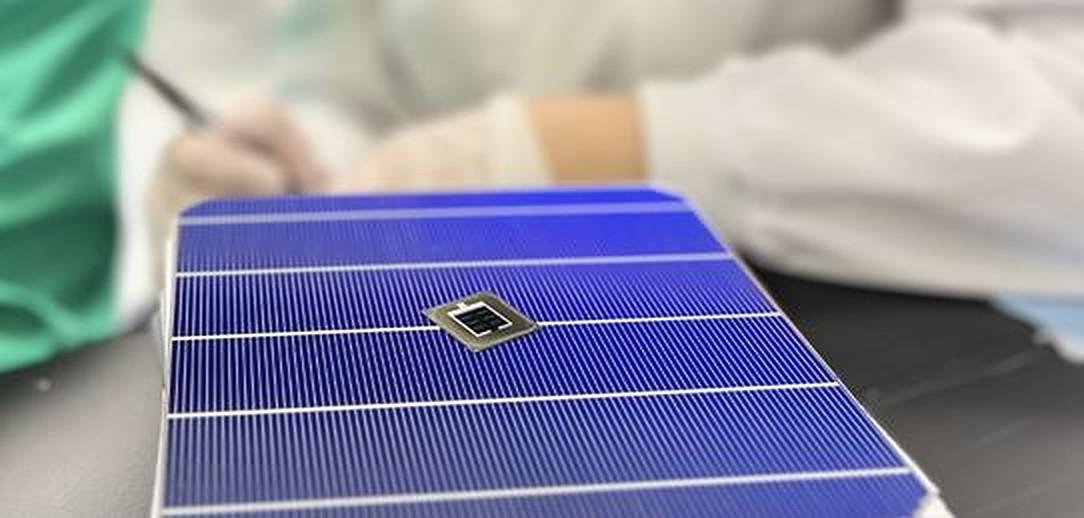Researchers at the King Abdullah University of Science and Technology (KAUST) in Saudi Arabia have fabricated a semitransparent four-terminal (4T) perovskite-perovskite-silicon tandem solar cell with an active area of 1 cm2.
“After dual-junction perovskite/silicon solar cells come triple-junction perovskite/perovskite/silicon tandems,” the research's lead author, Stefaan De Wolf told pv magazine. “However, processing compatibility may be a significant challenge when depositing so many layers, where in particular the recombination junction between the perovskite top and perovskite mid cell may be challenging. Moreover, with this approach, the top cell is deposited on glass, opening the design space towards high-efficiency and robust top cells.”
The scientists said that the key feature of the new tandem device was the hole transport layer (HTL) of the top cell, which was engineered with self-assembled monolayers (SAMs) based on a compound known as poly(9,9-bis(3′-(N,N-dimethyl)-N-ethylammoinium-propyl-2,7-fluorene)-alt-2,7-(9,9 dioctylfluorene))dibromide (PFN-Br), which was in turn combined with sputtered nickel oxide (NiOx).
The top perovskite solar cell was built with a substrate made of glass and indium tin oxide (ITO), the HTL based on carbazole (2PACz), PFN-Br, and NiOx, an absorber relying on a perovskite material known as Cs0.1FA0.9PbI1Br1.96Cl0.04, an electron transport layer based on buckminsterfullerene (C60) and tin(IV) oxide (SnO2) layer, an ITO electrode, a silver (Ag) metal contact, and an anti-reflective coating based on magnesium fluoride (MgF2).
This device achieved a power conversion efficiency of 14.3%, an open-circuit voltage of 1.402 V, a short-circuit current density of 12.5 mA/cm2, and a fill factor of 81.5%
The mid perovskite device and the bottom silicon cell were integrated into a monolithic perovskite/silicon tandem cell which achieved an efficiency of 17.2%, an open-circuit voltage of 1.783 V, a short-circuit current density of 11.6 mA/cm2, and a fill factor of 83.0%.
The tandem device was able to reach an efficiency of 31.5%, which the scientists said is the highest efficiency ever reported for perovskite-based 4-T and triple-junction tandem solar cells to date. Furthermore, they found that all devices were able to retain 80% of their initial efficiency after 1,500 minutes of maximum power point tracking, which they described as a “significant” result for the 2.0 eV-bandgap organic−inorganic perovskite material they chose for the top cell.
“The HTL exhibited a wide distribution in all PV parameters, with one-third of all devices being fully shunted,” the researchers said. “This fully shunted performance originates from the not fully covered perovskite films in the device, attributed to the hydrophobic surface of 2PACz anchored ITO substrates.”
The new cell was described in the paper “Four-Terminal Perovskite/Perovskite/Silicon Triple-Junction Tandem Solar Cells with over 30% Power Conversion Efficiency,” published in ACS Energy Lett. “The results underscore the potential of the triple-junction tandem solar cells and emphasize the importance of proper interconnection layers between perovskite and perovskite in monolithic 3-J solar cells to unlock their full potential,” the academics concluded.
In January, KAUST announced it fabricated a perovskite-perovskite-silicon triple-junction solar cell with a power conversion efficiency of 26.4%. In May 2023, it achieved an efficiency of 33.7% for a perovskite-silicon tandem solar cell.
A few months earlier, the Saudi university announced an efficiency of 28.1% for a perovskite-silicon tandem solar cell based on textured silicon wafers. In August 2022, it claimed a 26.2% efficiency for a monolithic perovskite-silicon tandem photovoltaic device.
In December 2021, KAUST researchers achieved a power conversion efficiency of 28.2% for a tandem solar cell with an area of around 1 cm2, based on an n-i-p perovskite stacked on top of a silicon heterojunction.
The same research group recently announced an inverted perovskite-silicon tandem solar cell with a 1 nm interlayer based on magnesium fluoride (MgFx) placed between the perovskite layer and the hole transport layer (HTL) to reduce voltage losses.
This content is protected by copyright and may not be reused. If you want to cooperate with us and would like to reuse some of our content, please contact: editors@pv-magazine.com.




By submitting this form you agree to pv magazine using your data for the purposes of publishing your comment.
Your personal data will only be disclosed or otherwise transmitted to third parties for the purposes of spam filtering or if this is necessary for technical maintenance of the website. Any other transfer to third parties will not take place unless this is justified on the basis of applicable data protection regulations or if pv magazine is legally obliged to do so.
You may revoke this consent at any time with effect for the future, in which case your personal data will be deleted immediately. Otherwise, your data will be deleted if pv magazine has processed your request or the purpose of data storage is fulfilled.
Further information on data privacy can be found in our Data Protection Policy.